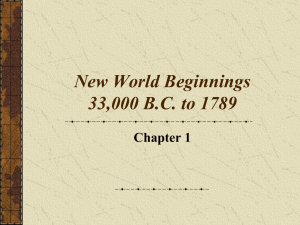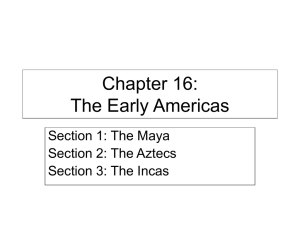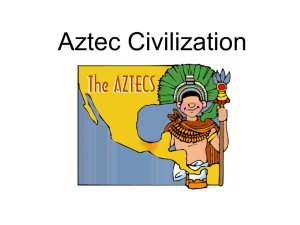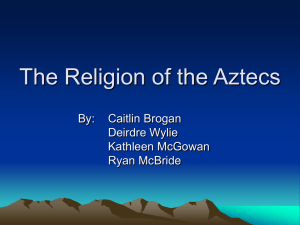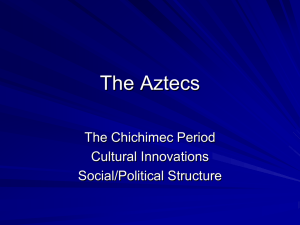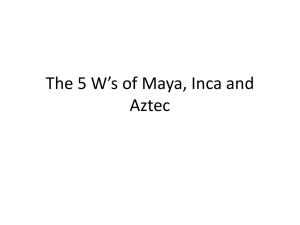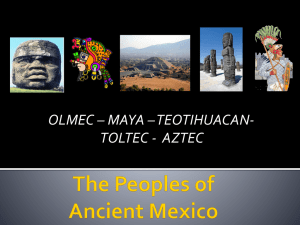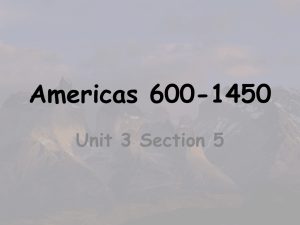unit 3: early american civilizations
advertisement
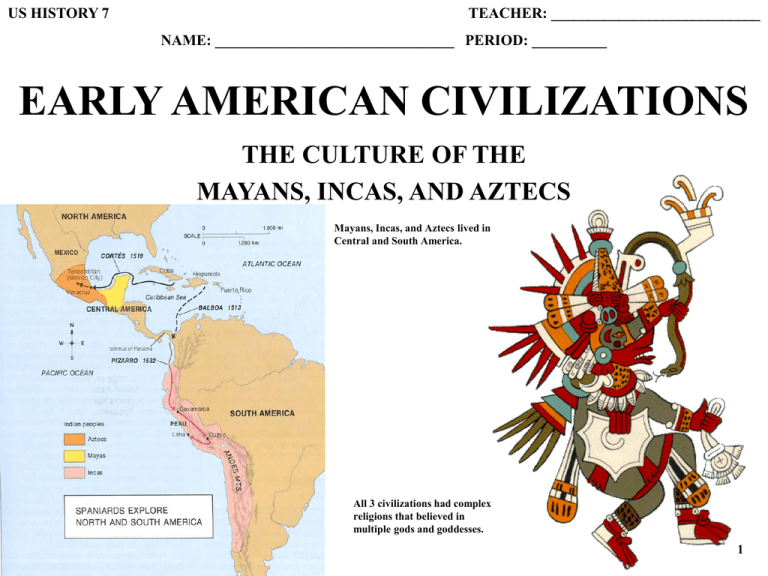
US HISTORY 7 TEACHER: ____________________________ NAME: ________________________________ PERIOD: __________ EARLY AMERICAN CIVILIZATIONS THE CULTURE OF THE MAYANS, INCAS, AND AZTECS Mayans, Incas, and Aztecs lived in Central and South America. All 3 civilizations had complex religions that believed in multiple gods and goddesses. 1 1 STUDENT NOTES: *Around 9,500 years ago, some groups of Native Americans in __________________ and _____________ America learned how to plant seeds and grow food. -This is the beginning of ____________________ in the America’s. -______________ (maize), pumpkins, peppers, _____________, ________________, cotton, and tobacco. -People could now settle down in one area and not live as ______________________. People needed to stay in one area in order to plant seeds, tend crops, and harvest crops. Human civilizations begin to develop in the Americas. NOMAD: ______________________________________________________________ Farming: Corn -Corn -Squash -Beans CIVILIZATION: _______________________________________________________ 3 Early American Civilizations: *All 3 early American civilizations existed in Central and South America and are considered empires. 1. Mayan Empire (__________-__________) 2. Inca Empire (__________-__________) 3. Aztec Empire (__________-__________) EMPIRE: _____________________________________ Aztec priests conducting religious sacrifice. ______________________________________________ *These civilizations and other groups of Native Americans developed different and unique cultures. Aztec government under the Emperor. CULTURE: ___________________________________ ______________________________________________ -Cultures were different mainly due to the geography or __________________ and the resources they had. -Culture includes a people’s language, customs, religion, government, economy, traditions, etc. 2 1. Mayan Empire: 200 AD – 900 AD (Mayan culture emerged around 50 BC) -Southern Mexico into Central America. -Government ruled by ________________. -Social Classes based on birth. -Built cities centered around religious temples to gods and goddesses. -Used human sacrifices. -Built pyramids as temples. -Studied the stars and developed a __________________. -Invented writing system using ____________________. -Invented system of mathematics. -Conquered by the Spanish. Mayan ruler holding audience in palace. Mayan religious pyramid. Much of Empire in Andes Mountains. Mayan hieroglyphic writing. 2. Inca Empire: 1200 AD – 1535 AD -South America along ___________ _____________. -Very organized government with king. -King worshipped as a god. -Conquered and ruled many other tribes. -Built vast network of roads and bridges. -Built terraces on hills for farming. Built vast network of roads. Macchu Picchu: Inca Palace. 3 3 3. Aztec Empire: 1300 AD – 1535 AD -Located in Central and Southern ________________. -Built capital city of Tenochtitlan. -Created strict legal code. -Created 365 day calendar. -Created writing system. -Built irrigation systems for crops. -Religion was ______________________: Believed in many gods. -Used human sacrifices to satisfy gods. -Conquered and ruled many other tribes. -Social Classes: Ruler, priests and nobles, warriors, merchants and artisans, farmers, and slaves. Human sacrifice to keep gods happy. Emperor Moctezuma Tenochtitlan Warrior in armor. Aztecs had a huge supply of gold in their empire. Slaves captured in battle being sold. 4 1492: EUROPEANS ENTER AMERICA -Spanish enter the America’s in 1492 when __________________ “discovers” the New World. -Spanish see the ____________ that the Native Americans have and they want it. -_____________ defeats and conquers the Aztec Empire. -_____________ defeats the Incan Empire. -Spanish had better ____________________ and technology and easily defeated the Aztecs, Incans, and Mayans. -Spanish: ________________, metal swords and spears, cannon, horses, and metal armor. -Aztecs: Wooden armor, bows/arrows, and spears with stone tips. Effects of Europeans: Due to ____________ and European _________________, the population of Native Americans decreased sharply. -European diseases, such as _________________, measles, and the flu killed millions of Native Americans. -The Spanish will do the following to the Native Americans: 1. Take their __________________ 2. Steal their ____________ and silver. 3. Kill millions of Native Americans through warfare and diseases. 4. Make them _____________ and force them to work for the Spanish. *At the time _________________ discovered the New World, there were only 3 civilizations in the America’s. North America was inhabited by hundreds of tribes of Native Americans. -North American groups: -Mound Builders -Iroquois: New York -Anasazi -Algonquin: New York -Hohokam Cortes speaking with Moctezuma. Spanish attacking Aztec city. In a period of 80 years, the population of Central America went down by 24 million people. 2 Aztecs that have died from smallpox and are going to their version of heaven. TRIBE: _______________________________________________ ______________________________________________________ 55 THE MAYANS: The Mayan civilization was the earliest of the three early American civilizations. The Mayan culture emerged around 50 BC. The Mayans created their empire starting around 200 AD. The empire lasted until around 900 AD. At this time, the Mayan civilization began to decline. The Mayans were a peaceful, agricultural people. They lived in parts of present-day Mexico, El Salvador, Honduras, and Guatemala, and Belize. The Mayans continued to flourish in many areas until the mid-1500’s, when they were conquered by the Spanish. MAYAN SOCIAL STRUCTURE: Mayan society was divided into social classes which consisted of the following: the king, nobles and priests, warriors, merchants, artisans, and farmers. At the bottom of society were the slaves. People became slaves by being captured in war, by being born into slavery, or by being orphaned. The king, who was a monarch, ruled the empire. A monarchy is a system of government in which a king or queen holds power. A slave is a person who is the property of another and under their control. MAYAN RELIGION: The Mayan had a nature-based, polytheistic religion. A polytheistic religion is a religion in which there are more than one god. A monotheistic religion is a religion in which there is only one god. They believed that all things in the universe had a spiritual component. The many gods were connected by a spiritual force, which meant that the gods were both many and one at the same time. People needed the gods, and the gods needed people in order to survive and prosper. To ensure that the gods would be good to the people, honor and sacrifice had to be made in the form of celebrations, bloodletting, and offerings of food or human life. MAYAN CITIES: Tikal was the primary city and trading center of the Mayan for about 400 years. At its height it was home to an estimated 50,000 inhabitants. Tikal was one of the world’s leading cities at a time when London and Paris were still small towns. The population lived mainly in and around the cities. Family compounds were too close together to permit much in the way of large-scale farming near the urban center. MAYAN ACCOMPLISHMENTS: The Mayan civilization contributed outstanding examples of architecture, city design, art, sculpture, pottery, carving, precious stone jewelry, painting, writing, books, math, calendars, and astronomy. The Maya created the first writing system in the Americas and wrote their hieroglyphs on buildings, bones, pottery, stone, and even in books. They also made great discoveries in mathematics. They created a system for counting using a base of twenty; it used a symbol for zero along with dots and lines. Time was extremely important to the Maya and they invented complex and accurate calendars. The Maya used astronomy to influence the design, relationship, and placement of their cities and buildings to reflect the happenings in the heavens over the solar year. STOP 1 6 THE INCAS: The Incan civilization was centered in the Andes Mountains in what is now Peru, South America. The civilization extended from the Isthmus of Panama to the Amazon Basin southwest to modern-day Chile. The Incas’ control of this area began in 1200 AD and ended with the Spanish conquest in 1535. INCAN SOCIETY: The society of the Incas was highly ordered and rigidly structured. At the top of society was the emperor, or Sapa Inca, who was believed to be the son of the sun god. Just below the Sapa Inca and his wife were the chief administrators of the empire. They were usually related to the emperor and were also considered part of the nobility. Next came the lesser administrators, military leaders, judges, and high civil servants. Under this privileged class were the specialized craftsmen and lesser local officials. At the lowest level were the farmers, who made up the largest portion of the Incan population. Conquered peoples became fiefs of the Sapa Inca and were taxed as such. Atahualpa (1502-1533) was the last emperor of the Incas. He ruled the northern part of the empire from the city of Quito while his brother ruled the southern part from the city of Cuzco. Cuzco was the traditional capital of the Incan Empire. A devastating civil war occurred between the brothers for control of the empire. A civil war is a conflict between different groups in the same country. Atahualpa, who was chronicled as ambitious, brave, and popular with the army, was victorious. The price of victory, however, was high. Incan cities were destroyed, along with the economy and a significant percentage of the population. Economy is the system for producing and distributing goods to people. As Atahualpa was preparing to enter Cuzco in triumph, the Spanish explorer Francisco Pizarro was also entering the city with 180 men. Pizarro invited Atahualpa to attend a feast. The invitation was accepted. When Atahualpa arrived, he was ambushed and captured by Pizarro’s men. The emperor of the Incas rejected demands to accept the sovereignty of the Spanish king and the Christian faith. He offered to fill a large room with gold in return for his freedom. Pizarro agreed. After paying more than $50 million in gold by today’s standards, Atahualpa was strangled by Pizarro’s men. After the death of the Incan ruler, Pizarro marched into Cuzco and took control of the Incas’ land and its riches. The execution of Atahualpa meant the end of the Incan civilization. INCAN RELIGION: The Incan religion had a variety of gods headed by Viracocha, the Creator. Under him in importance were gods who were responsible for the Sun, Inti, and the Moon, Quilla. Because the world around them was filled with gods, accurate calendars of the timing and sequence of repeating natural events were developed by the priests so that celebrations and sacrifices could be timed precisely so as not to offend any particular god. Sacrifices could be in the form of animals, food, material goods, or humans. The Sapa Inca was the political and religious leader of the culture and his brother was usually designated the high priest. Women also played important roles in the Incan religion, and the Chosen Women, or Sun Virgins, served the religion as nuns. They were ruled by a high priestess, always of noble lineage. She was given the title Coya Pasca. The older women trained the young girls to perform their jobs. INCAN ACCOMPLISHMENTS: With a minimum of engineering equipment, the Incas constructed impressive temples, palaces, fortresses, stone buildings, and a network of stone roads, connecting all parts of the realm. These structures were precise in their measurements and proportion. Rope suspension bridges of up to 328 feet in length, irrigation canals, and aqueducts were also among their achievements. Bronze was used for making weapons, tools, and ornamentation. Incan buildings were often constructed from polygonal blocks, some with as many as 12 sides. These were fitted next to one another with great precision and without the use of mortar. Another typical feature of Incan architecture was the use of a masonry veneer to cover an adobe superstructure. The Incas were successful farmers, builders, scientists, astronomers, artists, potters, and metallurgists. They developed a method of growing plentiful crops on steep, high land by terracing and irrigating. Irrigate means to bring water to crops. Dozens of varieties of potato, corn, squash, pepper, and tobacco were grown. The Incas built cities and monumental structures from carefully carved rock, fitted together so expertly that a knife could not fit between the stones. 7 They built nearly 10,000 miles of roads carved out of the Andes Mountains. Suspension bridges were designed and constructed over ravines. They performed medicine and surgery. The Incan calendar had twelve 30-day months, each divided into three 10-day weeks. The remaining five days were used for festivals. All this was coordinated by sightings taken from four astronomical towers near the capital. Weaving, pottery, and metalwork were produced for functional, decorative, and religious purposes. Woven and dyed cloth was made from alpaca, llama, and vicuna wool and cotton. Only the Incan ruler could use gold, and it had to be of the finest workmanship. Gold and silver were formed into masks, statues, plates, goblets, ceremonial knives, and earplugs. Copper and bronze were used for some tools and weapons. STOP 2 THE AZTECS: The Aztec civilization centered around Lake Texcoco in the central valley of Mexico in what is now Mexico City. The Aztec civilization began in 1300 AD and ended with the Spanish conquest in 1535. AZTEC SOCIETY: The Aztecs had a highly developed social structure made up of three classes. Each class was then broken down into groups according to their occupations. The three classes were the upper class, the middle class, and the lower class. The lower class or commoners made up the majority of the population. Nobles, high priests, military officers, and government leaders were considered to be upper class. The Aztec ruler, called the Great Speaker, or Tlatoani, was chosen from a select group of princes. Farmers, laborers, craftspeople, servants, and vendors were members of the middle class. The lower class was made up of those who worked the fields of the upper or middle classes and those who worked for wages. There were also some slaves, but their status was mostly temporary; most were paying off debts or serving a sentence for a crime. Families lived together in either nuclear families or extended families. A nuclear family is a family that is made up of the mother, father, and children. An extended family is a family that is made up of the nuclear family and other relatives such as grandparents, aunts, uncles, and cousins. The upper class lived in or near the cities. Members of the middle class and specialists clustered where there was work or the potential for income. The serfs lived on the farmland surrounding the urban centers. Slaves were used for cheap labor, and for sacrifices. All non-noble men of the upper and middle classes had to serve in the military for several years. All classes with property or income had to pay taxes. Montezuma (1466-1520), the ninth Aztec emperor of Mexico, ruled over 11 million people. He ruled for 18 years and commanded the army through organized expeditions of conquest. He was strongly influenced by his belief in the god Huitzilopochtli. Montezuma also believed that at some point in the future, a white, bearded god would return to the land of the Aztecs and rule over the empire. When the white, bearded Spanish explorer Hernando Cortes arrived, he took advantage of this belief and Montezuma’s fear. The Aztec ruler tried to buy off Cortes with large quantities of gold and other tributes, but he was captured and imprisoned. When Montezuma showed submission to the Spanish, his people lost their respect for him. While attempting to speak with his subjects, he was attacked with stones and arrows by his own people. Montezuma died three days later from his wounds. AZTEC RELIGION: The religion of the Aztecs was polytheistic and based on the religions of the various peoples they had conquered or assimilated. The foundation was their natural environment, and each component of the environment had its own set of gods and, for the Aztecs, its own priestly order and organization. Natural events were the result of actions or conflicts of the main gods and many lesser ones. The calendar was designed to honor the many gods and was filled with celebrations. Sacrifices, including human sacrifices, made in order to gain the gods’ favor were an important part of the celebrations. Human sacrifice and bloodletting were often practiced by believers, and captured enemies were offered as human sacrifices. 8 AZTEC CITIES: Founded around the year 1345 AD, Tenochtitlan was the capital city of the Aztecs. It was located in Lake Texcoco on a series of natural and man-made islands connected to the shore by causeways. The city originated in the 1100’s when, according to Aztec belief, a god commanded the Aztecs to travel south. They reached their destination in the Valley of Mexico in 1248 AD and settled where they saw an eagle on a cactus, holding a snake in its mouth. Conflicts with other peoples caused some inhabitants of the valley to move to the island in the middle of the lake. The formal city of Tenochtitlan was founded between 1300 and 1375. The city flourished and grew very prosperous. It was protected from floods by dams. An aqueduct system brought fresh water from the mainland. Three causeways connected it to the mainland. The Aztecs placed flat reed mats on shallow areas of the lake, covered the reeds with soil, planted crops, and then farmed. Most of the city’s population was farmers, who left the city to farm and returned to the city to live. Craftspeople specialized and traded at a large central market. Large temples, pyramids, and other structures were built. People in surrounding areas sought military help from Tenochtitlan. In 1473, Tenochtitlan conquered Tlatelolco and the two populations combined into one huge city. The city was destroyed by Hernando Cortes in 1521 when he occupied the city. Cortes founded Mexico City on its ruins. AZTEC ACCOMPLISHMENTS: The Aztec civilization was able to develop a number of advances in the arts, sciences, politics, and agriculture. These developments could not have happened without a strong, wealthy central government. Accomplishments in the arts included sophisticated sculpture, architecture, fresco work, pottery, and precious-metal work. Their system of writing included pictorial hieroglyphics as well as abstract symbols. These were applied to astronomy and calendar use to record and predict historical and natural phenomena. The astronomy component dictated the layout and location of their great cities and the structures within. In the cities, the Aztecs practiced medicine and had running water. Politically, the Aztecs used an autocratic central government as a means to conquer and control surrounding peoples for the benefit of the Aztecs. To support this large society, the Aztecs created new methods for farming in their environment and introduced new domesticated plants to feed their people. Domesticate means to tame something for human use. STOP 3 9 VOCABULARY: Define the following terms. STOP 1: THE MAYANS 1. Monarchy: ________________________________________________________________________________________________________________________________ _____________________________________________________________________________________________________________________________________________ 2. Slave: _____________________________________________________________________________________________________________________________________ _____________________________________________________________________________________________________________________________________________ 3. Polytheistic: ________________________________________________________________________________________________________________________________ _____________________________________________________________________________________________________________________________________________ 4. Monotheistic: _______________________________________________________________________________________________________________________________ _____________________________________________________________________________________________________________________________________________ STOP 2: THE INCAS 5. Irrigate: _______________________________________________________________________________________________________________ ____________________ _____________________________________________________________________________________________________________________________________________ STOP 3: THE AZTECS 6. Domesticate: _______________________________________________________________________________________________________________________________ _____________________________________________________________________________________________________________________________________________ 7. Nuclear family:__________________________________________________________________________________________________________ ___________________ _____________________________________________________________________________________________________________________________________________ 8. Extended family: ____________________________________________________________________________________________________________________________ _____________________________________________________________________________________________________________________________________________ 10 EARLY CIVILIZATIONS OF THE AMERICAS DIRECTIONS: Fill in the chart below for the 3 early American civilizations. MAYANS INCAS AZTECS LOCATION: (Where did they live?) DATES: (When did the civilization exist?) GOVERNMENT: (What type of government?) (Who ran the government?) SOCIAL CLASSES: (List the social classes that they had.) RELIGION: (What type of religion did they have?) (What were the names of their god(s)?) (Who ran the religion?) (What types of rituals/ceremonies did they perform?) ACHIEVEMENTS: (What did they create, invent, or do that helped others?) 11 CRQ #1: COMPARISON OF AZTEC AND MAYAN CULTURES DIRECTIONS: Study the diagram and then answer the questions. 1. List 3 characteristics of the Aztec Empire that they DID NOT share with the Mayan Empire. _____________________________________________________________________________ _____________________________________________________________________________ _____________________________________________________________________________ 2. List 3 characteristics of the Mayan Empire that they DID NOT share with the Aztec Empire. _____________________________________________________________________________ _____________________________________________________________________________ _____________________________________________________________________________ 3. According to this diagram, which feature was a characteristic of both the Mayan and Aztec civilizations? (a) creation of floating gardens (c) improvement of fishing methods (b) use of the number zero (d) creation of a writing system CRQ #2: AZTEC SOCIETY DIRECTIONS: Study the diagram and then answer the questions. 1. Who ruled the Aztec Empire? _________________________________________________ ____________________________________________________________________________ 2. What jobs did the priests perform in the Aztec civilization? _________________________ ____________________________________________________________________________ 3. Explain one way in which the role of the warriors was important to the Aztec religion. ____________________________________________________________________________ ____________________________________________________________________________ 12 12 CRQ #3: AZTEC HUMAN SACRIFICES DIRECTIONS: Study the picture and then answer the questions. 1. What was the reason that the Aztec’s used human sacrifices? ________________________________________ ___________________________________________________________________________________________ 2. Who did the Aztec’s use for their human sacrifices? _______________________________________________ ___________________________________________________________________________________________ 3. Explain the relationship between the Aztec warriors and the Aztec religion with regard to the human sacrifices. ___________________________________________________________________________________________ ___________________________________________________________________________________________ CRQ #4: SPANISH CONQUERING THE AZTECS DIRECTIONS: Study the picture and then answer the questions. 1. What two things shown in the picture helped the Spanish conquer the Aztecs and other Native American groups? _______________________________________________________________________________ _______________________________________________________________________________ 2. Why does the picture show Native Americans fighting with the Spanish against the Aztecs? _______________________________________________________________________________ _______________________________________________________________________________ 3. What was one result or effect of the Spanish victory over the Aztecs? _______________________________________________________________________________ _______________________________________________________________________________ 13 CRQ #5: INDIAN POPULATION OF CENTRAL AMERICA DIRECTIONS: The line graph below shows the population of Native Americans in Central America between 1500 and 1620. Study the graph and then answer the questions. 1. What was the population of Native Americans in Central America around the year 1515? _____________________________________________________________________ _____________________________________________________________________ 2. What was the population of Native Americans in Central America around the year 1605? _____________________________________________________________________ _____________________________________________________________________ 3. (a) Did the population of Native Americans in Central America increase or decrease during this time period? (b) By how many people did the population increase or decrease? (a)__________________________________________________________________ _____________________________________________________________________ (b)__________________________________________________________________ _____________________________________________________________________ 4. Using this graph and your knowledge of social studies, explain why the population of Native Americans changed so dramatically between 1500 and 1620. _____________________________________________________________________ _____________________________________________________________________ 14 CRQ #6: ARCHAEOLOGICAL DIG: DRAWING CONCLUSIONS DIRECTIONS: Read the information below, study the diagram showing an archaeological dig site, and then answer the questions. Archaeologists are scientists who study artifacts left behind by earlier people in order to learn how they lived. Archaeologists search for artifacts by digging in areas where they suspect earlier people once lived. The following items were found in three different levels of a Native American archaeological dig site by archaeologists. 1. At which level of the dig site would archaeologists expect to find the most recent (newest) objects? __________________________________________________________ _____________________________________________________________________________________________________________________________________________ 2. At which level of the dig site would archaeologists expect to find the oldest objects? ______________________________________________________________________ _____________________________________________________________________________________________________________________________________________ 3. Based on the objects found in level 3, how did Native Americans live during this time period? ______________________________________________________________ _____________________________________________________________________________________________________________________________________________ 4. Based on the objects found in level 2, how did Native Americans live during this time period? ______________________________________________________________ _____________________________________________________________________________________________________________________________________________ 15 5. Based on the objects found in level 1, how did Native Americans live during this time period? ______________________________________________________________ _____________________________________________________________________________________________________________________________________________ THE CONQUISTADORS SEARCH FOR GOLD by an Aztec Eyewitness, 1550’s In the early 1500’s Spanish conquerors, known as conquistadors, explored both North and South America. One of these conquistadors was 34-year-old Hernando Cortes. Like Christopher Columbus, Cortes hoped to find gold and other riches. In 1519 Cortes and about 500 Spanish soldiers marched through present-day Mexico and conquered one of the largest empires in the world, the Aztec Empire. In the 1550’s an historian interviewed an Aztec eyewitness who had seen the Spanish conquest. This witness described how Cortes and his men acted when they seized the fabulous treasures of the empire’s capital city, Tenochtitlan. STOP 1 When the Spaniards were installed in the palace, they asked Montezuma, the emperor, about the city's resources and reserves and about the warriors' ensigns and shields. They questioned him closely and then demanded gold. Montezuma guided them to it. They surrounded him and crowded close with their weapons. He walked in the center, while they formed a circle around him. STOP 2 When they arrived at the treasure house ... the riches of gold and feathers were brought out to them: ornaments made of quetzal feathers, richly worked shields, disks of gold, the necklaces of the idols, ... gold greaves and bracelets and crowns .... The Spaniards burst into smiles; and their eyes shone with pleasure; they were delighted by them. They picked up the gold and fingered it like monkeys; they seemed to be transported by joy, as if their hearts were illumined and made new. STOP 3 The truth is that they longed and lusted for gold. Their bodies swelled with greed, and their hunger was ravenous; they hungered like pigs for that gold. They snatched at the golden ensigns, waved them from side to side and examined every inch of them .... The Spaniards immediately stripped the feathers from the gold shields and ensigns. They gathered all the gold into a great mound and set fire to everything else, regardless of its value. Then they melted down the gold into ingots. As for the precious green stones, they took only the best of them .... STOP 4 installed: settled Montezuma: Aztec emperor reserves: valuables ensigns: flags quetzal: kind of bird idols: statues of gods greaves: leg armor transported: carried away illumined: lit up lusted: wanted strongly ravenous: intense ingots: bars 16 Next they went to Montezuma's storehouse ... where his personal treasures were kept. The Spaniards grinned like little beasts and patted each other with delight. When they entered the hall of treasures, it was as if they had arrived in Paradise. They searched everywhere and coveted everything; they were slaves to their own greed. All of Montezuma's possessions were brought out: fine bracelets, necklaces with large stones, ankle rings with little gold bells, the royal crowns and all the royal finery, everything that belonged to the king and was reserved to him only. They seized these treasures as if they were their own, as if this plunder were merely a stroke of good luck. And when they had taken all the gold, they heaped up everything else in the middle of the patio. STOP 5 Paradise: heaven coveted: wanted finery: jewels and fancy clothing plunder: stealing patio: courtyard DIRECTIONS: Answer the questions below as you read the above article. STOP 1: Define the following term: Conquistador: _________________________________________________________________________________________________________________________________ _____________________________________________________________________________________________________________________________________________ STOP 1: What did the conquistadors hope to find in the America’s? _____________________________________________________________________________________ _____________________________________________________________________________________________________________________________________________ STOP 1: How many men did Cortes have with him when he conquered the Aztec Empire? ___________________________________________________________________ _____________________________________________________________________________________________________________________________________________ STOP 2: Who was Montezuma? __________________________________________________________________________________________________________________ _____________________________________________________________________________________________________________________________________________ STOP 2: Why did Montezuma lead the Spanish to the Aztec gold? ______________________________________________________________________________________ _____________________________________________________________________________________________________________________________________________ STOP 3: In this section, who does the eyewitness compare the conquistadors to? ___________________________________________________________________________ _____________________________________________________________________________________________________________________________________________ STOP 4: In this section, who does the eyewitness compare the conquistadors to? ___________________________________________________________________________ 17 _____________________________________________________________________________________________________________________________________________ STOP 5: In this section, who does the eyewitness compare the conquistadors to? ___________________________________________________________________________ _____________________________________________________________________________________________________________________________________________ STOP 5: Why do you suppose the eyewitness chose to make this comparison between the conquistadors and the animals? _____________________________________________________________________________________________________________________________________________ _____________________________________________________________________________________________________________________________________________ _____________________________________________________________________________________________________________________________________________ STOP 5: How did the Spaniards react when they saw the gold? _________________________________________________________________________________________ _____________________________________________________________________________________________________________________________________________ STOP 5: What types of “treasure” did the conquistadors find in the hall of treasure? _________________________________________________________________________ _____________________________________________________________________________________________________________________________________________ _____________________________________________________________________________________________________________________________________________ 18 MAP EXERCISE: GREAT EMPIRES OF THE AMERICAS DIRECTIONS: Use maps to complete the following map exercise. 1. Locate the following geographic features on the map and write the name next to the feature. -Caribbean Sea -North America -Pacific Ocean -Andes Mountains -South America -Atlantic Ocean -Cuba -Central America -Hispaniola 2. Locate the following early American empires and shade in their locations using different colored pencils. Place this information in the key. -Aztec Empire -Maya Empire -Inca Empire 3. Create a key in the blank box on the map showing the necessary information. 1919 READING ACTIVITY: BERNAL DIAZ: THE TRUE HISTORY OF THE CONQUEST OF NEW SPAIN DIRECTIONS: Read the selection on the Spanish in the New World and then answer the questions that follow. Bernal Diaz del Castillo (1492-1581) accompanied Hernan Cortes on his conquest of the Aztecs in present-day Mexico. Diaz wrote his history many years later to refute what he viewed as inaccurate accounts of the conquest. The following excerpt describes a meeting between Cortes and Moctezuma, the Aztec King, in the Aztec city of Tenochtitlan. “When we climbed to the top of the great temple there was a kind of platform, with huge stones where they put the poor Indians to be sacrificed, and an image like a dragon and other evil figures, with a great deal of blood that had been shed that day. Moctezuma, accompanied by two priests, came out from an oratory dedicated to the worship of his cursed idols…. Then Moctezuma took him (Cortes) by the hand and bade him look at his great city and at all the other cities rising from the water, and the many towns around the lake…. There we stood looking, for that large and evil temple was so high that it towered over everything. From there we could see all three of the causeways that led into the city…. We saw the fresh water that came from Chapultepec, which supplied the city, and the bridges on the three causeways, built at certain intervals so the water could go from one part of the lake to another, and a multitude of canoes, some arriving with provisions and others leaving with merchandise. We saw that every house in this great city and in the others built on the water could be reached only by wooden drawbridges or by canoe. We saw temples built like towers and fortresses in these cities, all white-washed; it was a sight to see…. After taking a good look and considering all that we had seen, we looked again at the great square and the throngs of people, some buying and others selling. The buzzing of their voices could be heard more than a league away. There were soldiers among us who had been in many parts of the world, in Constantinople and Rome and all over Italy, who said that they had never before seen a market place so large and so well laid out, and so filled with people.” 1. The scene described in this excerpt is of: a. a view of Tenochtitlan’s market and surroundings from the top of a tall temple b. an indoor temple with many statues c. a view of Tenochtitlan’s temple from the market place d. a view of the markets in Rome 2. Which of the following best describes the author’s view of the Aztecs? a. generous and busy b. evil and prosperous c. loving and kind d. athletic and loud 3. Which words and phrases in the excerpt above reveal the author’s opinion of the Aztec’s religion? _____________________________________________________________________________________________________________________________________________ _____________________________________________________________________________________________________________________________________________ 20 _____________________________________________________________________________________________________________________________________________ EARLY AMERICAN CIVILIZATIONS TEST REVIEW SHEET: DIRECTIONS: Complete the following review sheet to help prepare for the unit test. PART 1: VOCABULARY: Write out the definitions for the following terms. 1. SLAVE: __________________________________________________________________________________________________________________ _________________ 2. DOMESTICATE: ___________________________________________________________________________________________________________________________ 3. IRRIGATE: _______________________________________________________________________________________________________________ _________________ 4. NUCLEAR FAMILY : ______________________________________________________________________________________________________________________ 5. EXTENDED FAMILY: ________________________________________________________________________________________________________ ______________ 6. POLYTHEISTIC: ___________________________________________________________________________________________________________ ________________ 7. MONOTHEISTIC: __________________________________________________________________________________________________________________________ 8. MONARCHY: _____________________________________________________________________________________________________________________________ 9. NOMAD: __________________________________________________________________________________________________________________ _______________ 10. CIVILIZATION: __________________________________________________________________________________________________________ _________________ 11. CULTURE: _______________________________________________________________________________________________________________________________ 12. TRIBE: _________________________________________________________________________________________________________________ _________________ 13. HIEROGLYPHICS: ________________________________________________________________________________________________________________________ PART 2: MULTIPLE CHOICE: Answer the following questions to help understand the ideas and concepts covered in this unit. 1. What were the native people of the Americas known as? ____________________________________________________________________________________________ 2. What type of government was used by the Mayans, Incans, and Aztecs? ________________________________________________________________________________ 3. Which civilization built a complex system of roads and bridges to link their empire? ______________________________________________________________________ 4. Which of the American civilizations was the oldest civilization? ______________________________________________________________________________________ 5. Which civilization developed a system of numbers including the concept of zero? ________________________________________________________________________ 21 6. Where did the Incans and Aztecs live? ___________________________________________________________________________________________________________________________ 7. What type of religion did the early American civilizations have? ______________________________________________________________________________________________________ 8. List several of the achievements/accomplishments of the Aztecs. _____________________________________________________________________________________________________ ____________________________________________________________________________________________________________________________________________________________ 9. Why did the Aztecs fight so many battles with other groups of Native Americans? _______________________________________________________________________________________ ____________________________________________________________________________________________________________________________________________________________ 10. What was the title given to the person who ruled the Aztecs? ________________________________________________________________________________________________________ 11. Which of the early American civilizations built their capital on an island in a lake? ______________________________________________________________________________________ 12. Why did the Aztecs use human sacrifices? ______________________________________________________________________________________________________________________ ____________________________________________________________________________________________________________________________________________________________ For MULTIPLE CHOICE questions 19-25 on the test, you need to study and understand CRQ’s 2 and 5 on pages 7 and 9 of this packet. For the SHORT ANSWER questions on the test, you need to study CRQ;’s 1, 3, and 4 on pages 7-8 of this packet. 22 _____________________________________________________________________________________________________________________ _____________________________________________________________________________________________________________________ _____________________________________________________________________________________________________________________ _____________________________________________________________________________________________________________________ _____________________________________________________________________________________________________________________ _____________________________________________________________________________________________________________________ _____________________________________________________________________________________________________________________ _____________________________________________________________________________________________________________________ _____________________________________________________________________________________________________________________ _____________________________________________________________________________________________________________________ _____________________________________________________________________________________________________________________ _____________________________________________________________________________________________________________________ 23 _____________________________________________________________________________________________________________________ _____________________________________________________________________________________________________________________ _____________________________________________________________________________________________________________________ _____________________________________________________________________________________________________________________ _____________________________________________________________________________________________________________________ _____________________________________________________________________________________________________________________ _____________________________________________________________________________________________________________________ _____________________________________________________________________________________________________________________ _____________________________________________________________________________________________________________________ _____________________________________________________________________________________________________________________ _____________________________________________________________________________________________________________________ _____________________________________________________________________________________________________________________ _____________________________________________________________________________________________________________________ 24 _____________________________________________________________________________________________________________________ _____________________________________________________________________________________________________________________ _____________________________________________________________________________________________________________________ _____________________________________________________________________________________________________________________ _____________________________________________________________________________________________________________________ _____________________________________________________________________________________________________________________ _____________________________________________________________________________________________________________________ _____________________________________________________________________________________________________________________ _____________________________________________________________________________________________________________________ _____________________________________________________________________________________________________________________ _____________________________________________________________________________________________________________________ _____________________________________________________________________________________________________________________ _____________________________________________________________________________________________________________________ 25 _____________________________________________________________________________________________________________________ _____________________________________________________________________________________________________________________ _____________________________________________________________________________________________________________________ _____________________________________________________________________________________________________________________ _____________________________________________________________________________________________________________________ _____________________________________________________________________________________________________________________ _____________________________________________________________________________________________________________________ _____________________________________________________________________________________________________________________ _____________________________________________________________________________________________________________________ _____________________________________________________________________________________________________________________ _____________________________________________________________________________________________________________________ _____________________________________________________________________________________________________________________ _____________________________________________________________________________________________________________________ 26 _____________________________________________________________________________________________________________________

